Add this eBook to your basket to receive access to all 84 records. Our indexes include entries for the spelling luddington. In the period you have requested, we have the following 84 records (displaying 71 to 80): These sample scans are from the original record. You will get scans of the full pages or articles where the surname you searched for has been found. Your web browser may prevent the sample windows from opening; in this case please change your browser settings to allow pop-up windows from this site.  Queen's South Africa Medal: Royal Horse Artillery: M Battery
(1901-1905) Queen's South Africa Medal: Royal Horse Artillery: M Battery
(1901-1905)
The nominal roll for the Queen Victoria's South Africa Medal - awarded (after her death, in the event) to all who had served honourably in the various campaigns in the Boer War - was compiled from these returns from the individual units. Two sets of form were completed. The main one, as in the sample scan, dates from 1901 and gives regimental number, rank, and full name (surname first), followed by a series of columns relating to different actions - Belmont, Modder River, Paardeberg, Dreifontein, Wepener, Johannesburg, Diamond Hill, Belfast, Wittebergen, Defence of Kimberley, Relief of Kimberley, Defence of Mafeking, Relief of Mafeking, Cape Colony, Orange Free State, Transvaal, Rhodesia, Talana, Elandslaagte, Tugela Heights, Defence of Ladysmith, Relief of Ladysmith, Laing's Nek, and Natal; each entitled the man to a separate clasp to the medal, and a tick or a Yes in the appropriate column indicates the man's actual physical presence in that battle. A final column for remarks is important in those cases where the man was no longer in the unit, by removal, death or desertion. The second form that sometimes occurs was returned in 1905, and covers men entitled to the Second South African War Medal and Clasps. It lists men by number, rank and name, checks whether they had claimed the Queen's South Africa Medal, and then enquires as to their suitability as to three Colony Clasps, which could be awarded for service in the Cape, Orange Free, or Transvaal; whether entitled to Date Clasps (South Africa 1901 and South Africa 1902); whether also entitled to the King's South Africa Medal; any other corps in which served in South Africa; and remarks (such as becoming non-effective, forfeiture, &c.) WO 100/139 | Sample scan, click to enlarge

| Members of Durham University
(1910)
The alphabetical list of all living members of Durham University, issued in 1910, was compiled from the Admission Book and University Register. It gives surname, initials, degree, college, and date. Those marked with an asterisk were Members of Convocation. In the case of graduates in Arts, Theology (except in the case of Bachelors of Divinity) and Civil Law, the dates refer to the year in which the examination for the degree of B.A. was passed; in the case of Bachelors of Divinity who were not Graduates in Arts, of Licentiates in Theology, of Civil Engineers, and of Licentiates in Medicine, to the year in which each passed the Final Examination. In the case of Hygiene, Science, and Music, to the year in which the Examination for B.Hy., B.Sc., or B.Mus. was passed; and in the case of Graduates in Medicine to the year in which the Examination for the degree of M.B. was passed, except in the case of practitioners, when the date refers to the year in which the examination for the degree specified was passed. In cases where no date is given the degree is Ad Eundem, unless it is marked honorary. The abbreviations are: Arms., Armstrong College, Newcastle-upon-Tyne; Codr., Codrington College, Barbados; Cos., Bishop Cosin's Hall; F. Bay, Fourah Bay, Sierra Leone; Hatf., Bishop Hatfield's Hall; Med., College of Medicine, Newcastle-upon-Tyne; St. Chad's, St Chad's Hall; St. John's, St John's Hall; Univ., University College. | Sample scan, click to enlarge

| Chemists and Druggists
(1919)
The official register printed under the direction of the Pharmaceutical Society of Great Britain pursuant to the act of 31 & 32 Victoriae, cap. 121 (An Act to Regulate the Sale of Poisons, and Alter and Amend the Pharmacy Act, 1852) comprised two sections:
1.The Register of Pharmaceutical Chemists, giving date of registration, number of examination certificate, full name (surname first, in capitals), and residence;
2. The Register of Chemists and Druggists, giving date of registration, full name (surname first, in capitals), residence, number of examination certificate (major or minor), and qualification. | Sample scan, click to enlarge

| Boys entering Wellington College in Berkshire
(1929)
Wellington College, near Wokingham, was originally founded for the education of sons of military officers. A register of boys entering the school from First Term 1859 to Michaelmas 1933 was compiled by F. G. Lawrence for the Old Wellingtonian Society. In each entry the boy's name is given in full, in bold, surname first; age at entry (usually 11 to 14); then, in brackets, the name of the dormitory or house to which he belonged, in italics, with the years of his stay; then his father's name (usually surname and initials, but not christian name) with military decorations where appropriate. School prefects and captains are noted as such; if the boy played cricket for the school, XI with the years; academic honours, scholarships, &c.; a brief biography; and date of death, or (where known) address in 1933. | Sample scan, click to enlarge
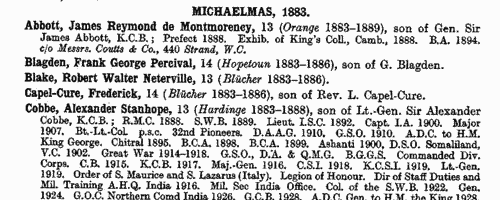
| Officers of the British Army and of the Indian Army
(1934)
The Half-Yearly Army List, issued By Authority, 30 June 1934, lists all officers in active service at that date, and this list was evidence of the status and rank of the officers contained in it. The entries are set out as a gradation list, by rank, from field-marshals to lieutenants, and within each rank in order of seniority at that rank. Each officer's name (surname first, in capitals, then christian name and present rank (with date of achieving that rank) and regiment &c. are given, for convenience, in bold type, with any national decorations in italics after the name. Each entry also gives date of birth, number of days service in the ranks, dates of service in each rank of officer, particular offices and postings (with dates) and, where appropriate, a summary of war service, and medals. For all but the oldest of the officers then serving, the war service details are for the Great War (1914-1921), and campaigns in Iraq, Waziristan, and the North West Frontier of India. War services are not given in this edition for Indian Army officers, except in that their entries are preceded by a crossed swords symbol where they have seen war service in a theatre of war overseas. After the gradation list of officers, there is a section for the Royal Malta Artillery; and then (pages 1152 to 1185) warrant officers - staff or garrison serjeant-majors, educational serjeant-majors, serjeant-major (physical training and educational) instructors, regimental serjeant-majors (and corporal-majors, farrier-serjeant majors, master gunners, assistant instructors in gunnery, experimental serjeant-majors, artillery clerks, farrier-serjeant-majors, artificer serjeant-majors, clerks of works, mechanist, superintending clerks, draughtsmen, 1st class staff serjeant-majors, transport, supply, conductors, sub-conductors, armourers, armament artificers, headmasters, schoolmasters, marine gunners, and bandmasters. The section for the Royal Army Chaplains' Department lists all chaplains (1st to 3rd class); and that for Queen Alexandra's Imperial Military Nursing Service has all matrons, sisters and staff nurses. The lists of nurses do not give date of birth: all are unmarried. The book concludes with the Yeomen of the Guard, the Honourable Company of Gentlemen-at-Arms, and the King's Body Guard for Scotland, in each case giving name (surname and initials, not christian names), honours, name of late regiment, and date of appointment.
| Sample scan, click to enlarge

| Members of Cambridge University
(1935)
The Cambridge University Calendar for 1935-1936 includes this list of all living members of the university, i. e. not only undergraduates and members of staff, but also all surviving graduates from earlier generations. The names are arranged alphabetically by surname, then by college in order of foundation, and under the particular colleges by order of seniority of the B. A. degree. Surnames are given, initials, name of college, and then the years of graduating B. A. and M. A. Where a change of name had occurred since matriculation, the original name is inserted in brackets. For undergraduates the term of matriculation is given in square brackets with an M for Michaelmas, L for Lent or E for Easter. An asterisk before a surname indicates a member of the Senate. Names which appeared on the roll of the Regent House promulgated in November 1934 are marked with a dagger. Further degrees, such as PHD, MB, BCHIR, MD, &c. are listed in smaller capitals with the year conferred. | Sample scan, click to enlarge
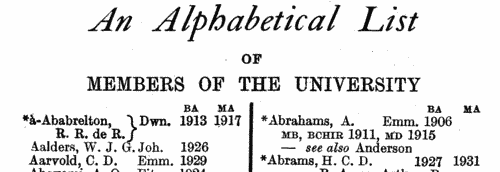
| Picture Judging Competition Prizewinners
(1935)
The 'Help Yourself' Society, inaugurated by The Stock Exchange Dramatic & Operatic Society, organized a picture judging competition for their Christmas Charity Fund, 1935. Of the thousands of entries received, 3,377 were awarded prizes, and there were also some consolation prizes. The prize list gives number (in order of merit), name and address. | Sample scan, click to enlarge
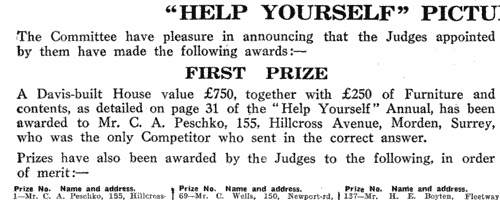
| Freemasons in St Edmund chapter, Bury St Edmunds
(1938)
List of members of the Ancient and Accepted Rite for England, Wales, the Dominions and Dependencies of the British Crown, January 1938. An asterisk before a name indicates a P. M. W. S. of the Chapter; the number 30 indicates a Grand Elected Knight, K. H., 30th Degree; 31, Grand Inspector Inquisitor Commander, 31st Degree; 32, Sublime Prince of the Royal Secret, 32nd Degree. | Sample scan, click to enlarge
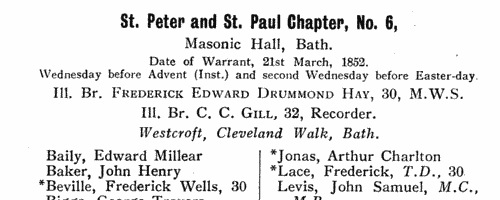
| Freemasons in the University chapter, Cambridge
(1938)
List of members of the Ancient and Accepted Rite for England, Wales, the Dominions and Dependencies of the British Crown, January 1938. An asterisk before a name indicates a P. M. W. S. of the Chapter; the number 30 indicates a Grand Elected Knight, K. H., 30th Degree; 31, Grand Inspector Inquisitor Commander, 31st Degree; 32, Sublime Prince of the Royal Secret, 32nd Degree. | Sample scan, click to enlarge
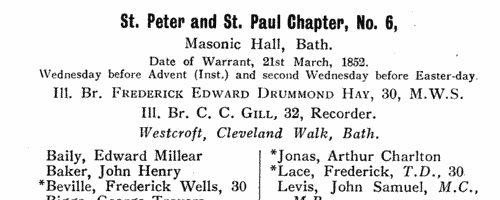
| Imperial Service Medal
(1946)
The Central Chancery of the Orders of Knighthood at St James's Palace announced these awards by king George VI of the Imperial Service Medal to members of the Home Civil Service. The names are arranged alphabetically by surname (in capitals) and christian names, with office or rank in the service. | Sample scan, click to enlarge
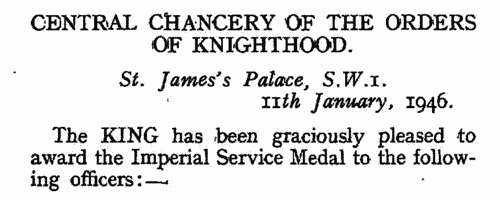
|
Research your ancestry, family history, genealogy and one-name study by direct access to original records and archives indexed by surname.
|












